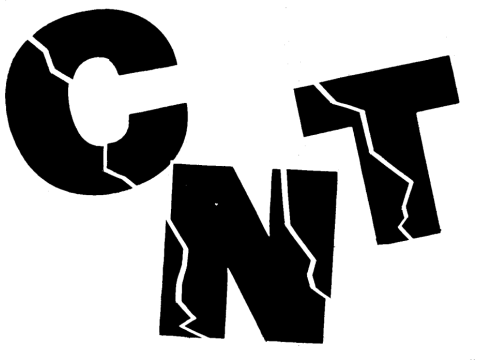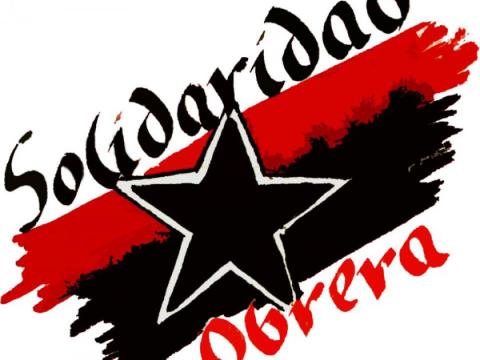An article on anarchism in Barcelona, mostly focusing on the CNT.

What is anarchy? What images does it bring to mind: squatters, violence, the recent events in Greece? A green Mohawk, combat boots, Barcelona? Anarchy is defined by Merriam-Webster’s dictionary as: absence of government; a state of lawlessness or political disorder due to the absence of governmental authority; a utopian society of individuals who enjoy complete freedom without government.
It is possible to argue that over the last 100 plus years, Barcelona has realized Merriam’s definitions by being both a state of disorder and a utopian society. Few people, Catalan or foreigner, are aware of Barcelona’s deep anarchist roots. This ideology, which at one time dominated the city, is still alive in Barcelona’s counterculture but has been forgotten by most of the rest of society.
History of Anarchy in Barcelona
In the 1930s in Barcelona (and indeed in other regions of Spain), anarchy was a respectable political dogma to which the majority of people subscribed. The same organization represented anarchy then as today: the Confederación Nacional de Trabajo (CNT). In 1931 the powerful anarchist organization had a huge membership of around 400,000 in Catalonia alone, which was mostly comprised of blue-collar workers.
The anarchists made a huge contribution to the Republicans during the Spanish Civil War, and are remembered as being brave fighters on the front. As George Orwell, who fought with the anarchists in the war, put it in his book Homage to Catalonia, “In Catalonia for the first few months, most of the actual power was in the hands of the Anarcho-Syndicalists, who controlled most of the key industries. The thing that happened in Spain was, in fact, not merely a civil war, but the beginning of a revolution.”
Barcelonese eco-anarchist Dídac S. Costa agrees with Orwell and told the Metropolitan that, “The CNT is the central body of a certain type of anarchism, syndicated anarchy, which historically had the most overall power in Spain and perhaps internationally too because of what they accomplished in the 1930s.”
Costa and Orwell are right. The 1930s were the glory days for anarchy in Barcelona, and those were certainly revolutionary times. After Franco won the war, however, anarchy and its followers were all but exterminated and driven into exile, a defeat from which they never quite recovered. The history of anarchy in Barcelona is a complex one, which could be why so much of it has been forgotten by society. There are a few key dates that are important to keep in mind when considering anarchy in Spain:
1873-1900: Farmers fed up with inequality begin to rise up in rural areas of Spain. The first seeds of anarchy are planted.
1907: Anarchist newspaper El Solidaridad is founded in Barcelona.
1909: The Tragic Week – a series of bloody confrontations occur between the army and the working classes throughout Catalonia – takes place.
1910: The CNT is created in Barcelona for workers, beginning syndicated anarchy in the region.
1930s: Anarchy enjoys widespread popularity and the CNT collectivizes Barcelona, from public transport to the telephone company.
1936: Federica Montseny becomes the first female anarchist minister in Western Europe.
1936-1939: Anarchists fight against fascism. Homage to Catalonia by George Orwell is based on time he spent with anarchists during this era.
1939-43: The Republic loses and Franco subsequently executes thousands of anarchists. The CNT becomes illegal and operates secretly in Spain and in France.
1960: Militant anarchists called Maquis use violence to combat Francismo. They are mostly unsuccessful and many of them die.
1975: Franco dies and CNT members come out of hiding.
1977: The Mitin de Montjuic occurs: 300,000 people come together in support of the CNT on Montjuic Mountain in Barcelona. Federica Montseny returns from exile.
1979: The CNT splits into two groups: the CNT, which has more traditional anarchist values and the Confederación Gerneral de Trabajo (CGT), which differs from the CNT in that it participates in elections.
2009: The CNT continues to survive with a mere 7,000 (aprox) members nationally. The CGT is much more popular. Anarchy in Barcelona is fractured and lacks the unity needed for real impact.
“It is impossible to understand Barcelona without understanding its anarchist past,” Mateo Rello recently told the Metropolitan. Mateo is the editor of the anarchist newspaper Solidaridad Obrera, often referred to as El Soli. The paper, which represents the CNT, was founded in 1907 and has been bringing anarchist news to Barcelona for over one hundred years. Rello, like the other thousand people working for the CNT in Barcelona, is a volunteer with a day job. Because the CNT is completely independent it does not take money from the Spanish government, private parties fund it.
When asked about how the CNT manages to keep its doors open in these tough financial times, Mateo says: “It’s not easy. We hold many events to fundraise but it’s difficult.” Besides a host of gatherings, talks, presentations and classes each month, the CNT also has a bookshop, Llibreria La Rosa de Foc.
Mateo estimates that there are about 7,000 registered CNT anarchists throughout all of Spain. That’s not too many when considering what membership used to be. The CNT is still largely associated with the violence of the 1970s and 1980s, and because of this many people in Barcelona are uninterested in the CNT or have a negative impression of it.
The other problem has been internal bickering between the CNT and the CGT. The CNT represents a more “pure” anarchist viewpoint, while its offshoot, the CGT, has more supporters nationally (15,000) but breaks some key rules of anarchy by participating in political elections. The CNT sees the CGT’s electoral participation as anti-anarchism, and the two groups have been arguing since their split 30 years ago. Mateo and others hope that steps can be taken to heal old wounds between the two groups, and that positive collaboration is on the horizon.
In the meantime, the CNT continues to try and educate people about the history of anarchy in Spain. The CNT also continues to fight, as it always has, for the rights of the worker, representing those who are displaced or ignored in society. The CNT’s hot issues these days are immigration (specifically getting work visas for immigrants), the Bolonia Plan and organizing boycotts against big businesses such as Mercadona.
While the CNT was the leading representative of anarchy in 20th century Spain, some would say that it’s nothing more than a symbol of the past and not up to date with the current anarchist movement.
In Homage to Catalonia George Orwell wrote: “Anarchism is deeply rooted in Spain and is likely outlive Communism when the Russian influence is withdrawn.” Written in 1938, this prediction was, in some senses, correct. Although the anarchy in Barcelona today is nothing like the revolution that Orwell witnessed, it is still present and a dynamic force in the city. Over the years the way anarchy has morphed and divided, adopting different labels and causes along the way. What has persevered is the spirit of the philosophy: the concept that human beings are able to decide what is best for them without government interference. Radical? Yes it is. But it was once a real possibility in Barcelona, and though it may never be adopted again as it was in the 1930’s, it is a part of the city’s history that is too important to be forgotten.
Regina Winkle-Bryan lives in Barcelona and writes on all things Spain. Barcelona’s anarchical spirit and non-conventional attitude regarding art, culture and politics have always fascinated her. Read more of her thoughts on Spanish and Catalan culture at: www.thespainscoop.com and www.regwb.com.
Originally posted: December 14, 2009 at Adbusters






Comments
This article contains a
This article contains a number of inaccuracies
-Characterization of the CNT as tiny. Yeah compared to the old days it is,but adjusted for population, an American equivalent would be almost 50,000 members, 15,000 more than UE, which although small, is never described as 'tiny'.
-The author can't seem to distinguish between the workplace elections and parliamentary elections, inferring that the CGT participated in the latter, which is untrue.
-Seems to place an amount of importance on Federica Montseny which I don't think really existed. The part on joining the government was significant because it violated anarchist principles and signalled the beginning of the end, not because it involved the first female anarchist minister in Western Europe.
-"The CNT is still largely associated with the violence of the 1970s and 1980s" Is that true? Seems like there are larger issues with the CNT current size than this...
Juan Conatz wrote: This
Juan Conatz
Right quick.
The CNT is "tiny" by trade union standards. The UE is tiny by trade union standards. Do "we" measure the CNT and the UE the same way? I'd hope not.
On "violence". I'm not sure I understand fully the reference. I am guessing it refers to the "violence" which was the work of State agents agaisnt the CNT gas attendents strike of (1979ish). And the La Scala incicent (1977ish). Those two incidents --- carried out by state agents --- were used against the CNT for long time. It is believed by many, inclusing many of us who support the CNT-AIT, that these violent incidents had an effect on the growth of the CNT.
Federica Montseny. I suspect her long family line as anarchits militants, her gender, her prom. role, both in Spain and exile, puts her in the spotlight. I recall the CNT-press at the time of her return to Spain as being full of coverage, etc. By no means was she fully beloved. But her return was symbolic ib that it marked a period where the exiled generation were able to travel to Spain.
syndicalist wrote: The CNT
syndicalist
I guess I'm more saying that maybe the writer is going into it based on North American or Western European standards, and IWW or explictly anarcho-syndicalist union in those places with 50,000 members would be a huge deal and indicate a level of struggle and activity that I would never describe as 'tiny'.